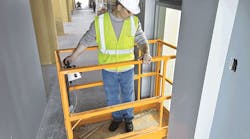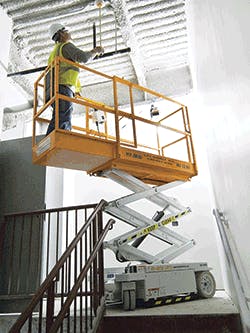Choosing a Low-Level Scissor Lift that Fits Your Project
Low-level scissor lifts are great tools for indoor projects, such as electrical installation or drywall hanging. They are easy to maneuver, have intuitive controls and most importantly, get you to the right working heights without lugging tools and building materials up ladders and scaffolds.
There are hundreds of different lifts on the market and picking the right lift optimizes productivity and operator safety on the jobsite, and adds a low-maintenance machine to any tool fleet. There are four features that should be considered before making a purchase: working height, platform size, worksite impact and lifting capacity.
Heightened Awareness
Less is more when it comes to interior working heights. Contractors might think they need a lift with working heights taller than 25 feet, when actually they may be able to reach all projects with one that reaches a 20-foot working height. In fact, roughly 70 percent of lift operators say their jobs required working heights lower than 25 feet.
Low-level scissor lifts have step-in heights as low as 20 inches, making it easy for operators to load tools and materials onto the platform. Low step-in heights eliminate the fatigue caused by climbing multiple ladder rungs; reduce the chance of a serious fall; and minimize repetitive strains that can create workers' compensation issues. Some manufacturers also incorporate a full swing gate, which makes platform loading easy and safe because the operator doesn't have to duck under chains or railings.
Using an oversized scissor lift for interior work, such as electrical installation, can endanger the operator. Crush hazards are a constant presence when operators use an oversized lift indoors because the platform height exceeds the ceiling height. For instance, if an installer is using a 20-foot lift inside a 20-foot-tall room, he or she might get distracted while looking down over the railing as the platform is nearing the ceiling, creating a potential crush hazard.
A low-level lift, on the other hand, has roughly a 15-foot-tall platform height, which allows the installer to achieve a 20-foot reach with virtually no crushing hazard.
Stowed height also is important for operators to consider when selecting a low-level lift.
If a lift is less than 6 feet tall with the platform fully lowered, operators can easily push or drive the lift under overhead fixtures, such as support beams and doorframes.
A low-level lift should be less than 3 feet wide and 6 feet long so operators easily can transport it or maneuver it through narrow pathways. Some drive-around, low-level lifts are as narrow as 2 1/2 feet, which is wide enough for an operator and any tools he or she might need, yet still small enough to fit through doorways and take up minimal space in narrow hallways. And a lift that is less than 6 feet long easily can fit inside most elevators.
Some lifts have platform extensions that give operators extra working space for an additional person or building materials. The extension also allows operators to work over obstacles that might prevent the lift from moving forward. For example, an operator can slide out the extension to install a lighting fixture over a stairway railing.
Minimizing Damage
Low-level lifts should have minimal or no impact on the worksite. Features such as dual front wheels, counter-rotating wheels and self-contained hydraulic systems prevent a chance of hydraulic oil leaking and damaging floors.
Weight also can damage floors, and low-level scissor lifts have some of the best weight distribution in the industry. Their wheels spread the lift's weight throughout the unit to reduce pressure on sensitive surfaces, including tile and stone floors. A 1,200-pound lift with dual front wheels might have wheel loads as low as 62.7 psi, which enables operators to maneuver the lift over floors with minimal risk of damage. The weight distribution also means operators can get onto poured concrete several days sooner than with heavier lifts.
Counter-rotating wheels also minimize the risk of damaging sensitive floors, allowing one side of the wheel to move forward, while the other moves back, which prevents bunching or twisting.
Hydraulic Options
Hydraulic lifts are known for their ability to lift heavy loads. Often, though, for indoor work, that kind of lifting power isn't necessary. Hydraulically driven lifts also have the potential for leaks, since they use hydraulic fluid to drive, lift and steer the lift. Hydraulically driven lifts also have multiple connection points between the hydraulic pump and systems, which increases the risk of a leak occurring.
If the lifting power of a hydraulic system is needed, some manufacturers offer electric-driven lifts with hydraulic systems that have only two connection points. These lifts use hydraulic systems that solely are dedicated to elevating the platform instead of driving, lifting and steering the lifts, which reduce the chance of leaks and generally have greater motor efficiency. And since connection points are a major source of hydraulic leaks, having only two connection points minimizes the chance of a leak occurring in multiple spots.
Locked In and Charged Up
When faced with a project that requires maneuvering through long hallways or during working hours, consider lifts that have castor locks and efficient, built-in charging systems. Some manufacturers include caster locks that limit the wheels' turning radius.
These locks, when engaged, make low-level lifts ideal for working in long hallways because they allow operators to drive easily in a straight path while permitting minor steering adjustments.
Customers also should consider features that protect the environment if they are purchasing low-level lifts. For example, some manufacturers build lifts that have electrical drive motors and steering systems. These systems draw fewer amps and require less overall power than hydraulically driven engines, which results in long operational hours – sometimes as long as 16 hours – and fewer recharges.
Some manufacturers also include an on-board battery charger that self-monitors the electrical current and stops it once the battery is fully charged. This reduces energy consumption and prevents the battery from overcharging, which can shorten its life. Some chargers also maintain batteries independently from each other instead of pushing the electrical current from one battery to the next. Combined with a self-monitoring system, they help ensure the equipment owner gets the most life from their battery.
It Lifts Me; It Lifts a Lot
Having a low-level scissor lift that can elevate workers and building materials while maintaining its stability is key to maximizing productivity. If an operator is hanging drywall, the lift needs to accommodate the worker, screws, tools and a couple of sheets of drywall. Plus, each sheet can weigh between 52 to 77 pounds depending on the size and material. This weight adds up quickly and can be a deciding factor when choosing a lift.
Low-level lifts vary in their lifting capacity. Some 10-foot lifts have 750-pound lifting capacities, which generally is enough to support two operators or a single operator and any building materials he or she may need on the jobsite. To minimize a scissor lift swaying under heavy loads, some manufacturers enhance platform stability by using a robust scissor stack and oversized pins.
Knowing what features fit your needs puts you ahead of the curve when it comes to selecting a low-level lift. The lift you choose should increase your productivity and minimize costly downtime on a wide range of applications. From hanging slabs of sheetrock to twisting in the final lightbulb, the best low-level lift safeguards the operator, the project and the production schedule from beginning to end.
Justin Kissinger is the marketing manager for Custom Equipment Inc. He has been with the family-owned business since 1998, and has experience in all areas of the company, including assembly, engineering, service and sales.

